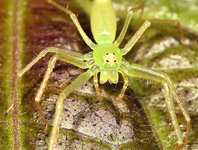Abstract
The monotypic genus Hindumanes Logunov, 2004 is revised. We present fresh specimens of Hindumanes karnatakaensis (Tikader & Biswas, 1978), the type species, and describe Hindumanes wayanadensis sp. nov. from the Wayanad Wildlife Sanctuary, a part of the Western Ghats, Kerala, India. This paper provides the first description of the male of H. karnatakaensis and a redescription of its female. We also transfer the genus from Asemoneinae Maddison, 2015 to Lyssomaninae Blackwall, 1877. The relationship between Hindumanes and Lyssomanes Hentz, 1845 and the zoogeography of the subfamily are discussed. The distribution records of the genus are mapped.
References
Briggs, J.C. (1995) Global Biogeography. Developments in Palaeontology and Stratigraphy. Vol. 14. Elsevier, Amsterdam, 452 pp.
Dawson, M.R., West, R.M., Langston, W. Jr. & Hutchison, J.H. (1976) Paleogene terrestrial vertebrates: northernmost occurrence, Ellesmere Island, Canada. Science, 192 (4241), 781–782.
https://doi.org/10.1126/science.192.4241.781Galiano, M.E. (1980) Revisión del género Lyssomanes Hentz, 1845 (Araneae, Salticidae). Opera Lilloana, 30, 1–104.
Galiano, M.E. (1984) New species of Lyssomanes Hentz, 1845 (Araneae, Salticidae). Bulletin of the British Arachnological Society, 6 (6), 268–276.
Galvis, W. (2017) New species and records of lyssomanines (Araneae: Salticidae: Lyssomaninae) from the Caribbean and the pacific coasts of Colombia. Zoology and Ecology, 27 (2), 133–142.
https://doi.org/10.1080/21658005.2017.1304188García-Villafuerte, M.A. & Penney, D. (2003) Lyssomanes (Araneae, Salticidae) in Oligocene-Miocene Chiapas amber. Journal of Arachnology, 31 (3), 400–404.
https://doi.org/10.1636/02-31Kumagai, H., Sweda, T., Hayashi, K., Kojima, S., Basinger, J.F., Shibuya, M. & Fukaoa, Y. (1995) Growth-ring analysis of Early Tertiary conifer woods from the Canadian High Arctic and its paleoclimatic interpretation. Palaeogeography, Palaeoclimatology, Palaeoecology, 116, 247–262.
https://doi.org/10.1016/0031-0182(94)00100-MLogunov, D.V. (2004) On the taxonomic position of “Lyssomanes” karnatakaensis and other Indian species formerly assigned to Lyssomanes (Araneae, Salticidae). Bulletin of the British Arachnological Society, 13, 73–75.
Logunov, D.V. (2014) New species and records of Lyssomanes Hentz, 1845 from Central and South Americas (Aranei: Salticidae). Arthropoda Selecta, 23, 57–56.
Logunov, D.V. & Marusik, Y.M. (2003) Taxonomic and faunistic notes on Chinoscopus Simon, 1900 and Lyssomanes Hentz, 1845 from the Neotropical Region (Araneae: Salticidae). Bulletin of the British Arachnological Society, 12 (9), 415–424.
Maddison, W.P. (2015) A phylogenetic classification of jumping spiders (Araneae: Salticidae). Journal of Arachnology, 43, 231–292.
https://doi.org/10.1636/arac-43-03-231-292Maddison, W.P. (2016) Sumakuru, a deeply-diverging new genus of Lyssomanine jumping spiders from Ecuador (Araneae: Salticidae). Zookeys, 614, 87–96.
https://doi.org/10.3897/zookeys.614.9368Maddison, W.P., Li, D.Q., Bodner, M.R., Zhang, J.X., Xu, X. & Liu, Q.Q. (2014) The deep phylogeny of jumping spiders (Araneae, Salticidae). ZooKeys, 440, 57–87.
https://doi.org/10.3897/zookeys.440.7891Myers, N., Mittermeier, R.A., Mittermeier, C.G., Fonseca, G.A.B. & Kent, J. (2000) Biodiversity hotspots for conservation priorities. Nature, 403, 853–858.
https://doi.org/10.1038/35002501Penney, D. & Selden, P. (2011) Fossil Spiders: The Evolutionary History of a Mega-diverse Order. Monograph Series. Vol. 1. Siri Scientific Press, Manchester, 127 pp.
Prószyński, J. (2017) Pragmatic classification of the World's Salticidae (Araneae). Ecologica Montenegrina, 12, 1–133.
Robbins, R.K., Duarte, M. (2006) Systematic placement of Lycaena cogina schaus (Lepidoptera: Lycaenidae: Polyommatinae), a biogeographically disjunct new world species. Proceedings of the Entomological Society of Washington, 108 (1), 226–236.
Su, K.F., Meier, R., Jackson, R.R., Harland, D.P. & Li, D. (2007) Convergent evolution of eye ultrastructure and divergent evolution of vision-mediated predatory behaviour in jumping spiders. Journal of Evolutionary Biology, 20, 1478–1489.
https://doi.org/10.1111/j.1420-9101.2007.01335.xTikader, B.K. & Biswas, B. (1978) Two new species of spiders of the family Lyssomanidae from India. Proceedings of the Indian Academy of Science, Animal Sciences-3, 87 B (9), 257–260.
Wanless, F.R. (1980) A revision of the spider genera Asemonea and Pandisus (Araneae: Salticidae). Bulletin of the British Museum of Natural History, Zoology, 39, 213–257.
https://doi.org/10.5962/bhl.part.13273West, R.M. & Dawson, M.R. (1978) Vertebrate paleontology and the Cenozoic history of the North Atlantic region. Polarforschung, 48 (1–2), 103–119.
Wheeler, W.M. (1922) Observations on Gigantiops destructor Fabricius and other leaping ants. Biological Bulletin, 42 (4), 185–201.
https://doi.org/10.2307/1536521Wolfe, J.A. (1978) A Paleobotanical Interpretation of Tertiary Climates in the Northern Hemisphere: Data from fossil plants make it possible to reconstruct Tertiary climatic changes, which may be correlated with changes in the inclination of the earth's rotational axis. American Scientist, 66 (6), 694–703.
World Spider Catalog (2017) World Spider Catalog. Version 18.5. Natural History Museum Bern. Available from: http://wsc.nmbe.ch (accessed 8 August 2017)
Wunderlich, J. (1986) Spinnenfauna gestern und heute. Fossil Spinnen in Bernstein und ihre heute lebenden Verwandten. Erich Bauer Verlag bei Quelle und Meyer, Wiesbaden, 283 pp.
Wunderlich, J. (1988) Die Fossilen Spinnen im Dominikanischen Bernstein. Beiträge zur Araneologie, 2, 1–378.

